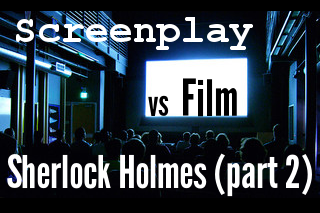Some time ago, I started writing about the screenwriting tips I learned by comparing the screenplay and film versions of Sherlock Holmes, the 2009 movie directed by Guy Ritchie, which was full of humor, heart, mystery & adventure.
So here is the long-awaited second part. If you missed it, click here for the first half of 13 Screenwriting Tips from Sherlock Holmes. And remember, we’ll be doing script vs film analyses every Tuesday, which should be a great resource for all you hoping to write for the movies.
Don’t hand your hero a solution on a silver platter
Your hero has to figure out things for himself. Information and solutions just can’t be handed over to him. Not only does that make your hero appear weak but it makes for a much less satisfying read. If your hero needs information or a solution, he has to earn them. Of course, he can have help, but nevertheless, he has to go through this process.
In the screenplay version of Sherlock Holmes, Blackwood tells Holmes, “at noon today, I will kill all of Parliament.” Where’s the drama in that? Okay, so Holmes, along with Watson and Irene, had snuck into a secret soiree Blackwood was hosting. Despite their disguises, they could’ve been discovered at any minute. Blackwood was killing other guests with just his touch, so there was some drama and tension in the scene, but when I read it, I felt cheated. What exactly was Blackwood’s plan was a question to which Holmes desperately needed the answer, and it seemed like it was just handed over to him.
Contrast this with the movie version in which Holmes knows what time Blackwood is going to act, but doesn’t know where. So he’s keenly aware he’s running out of time, and added to that, there’s a warrant out for his arrest. He reviews the evidence over and over — until finally, he deduces that Blackwood’s final act will occur at Parliament. Right after he reveals this brilliant deduction, he’s arrested!
Ok, now that I’ve described both versions, the first one doesn’t seem as lackluster as I originally thought. But I still think the second way is far better. Here’s why — Sherlock’s defining characteristic is his deductive abilities. It’s the reason why he, and he alone, can solve this particular mystery. So it makes sense that these deductive abilities will have to be used in the 13th hour in order to thwart Lord Blackwood. If your hero has a unique skill set that makes him especially suitable for overcoming the villain, follow Sherlock Holmes’s example, and put that skill on full display.
Keep your hero in the driver’s seat
In the movie version of Sherlock Holmes, there was a heart-pounding scene where Irene Adler was tied to a sort of conveyor belt which propelled her towards a saw which would’ve split her in half. Thankfully, Holmes and Watson rescue her with great risk to to themselves. In the screenplay, this story beat was written quite differently. Instead of Irene, Holmes was in danger. Watson and Irene had to save him from Dredger’s meaty hands and sharp razor.
The movie version was better from a screenwriting perspective because Holmes was doing the rescuing. That’s a major job requirement for the hero.
Whether male or female, the hero has to do the saving.
If your hero does get captured, he should escape due to his own ingenuity & skills. He can get help from a buddy (or love interest), but that help should only come at the last minute, when the hero is already halfway free himself or after he has escaped and faces a new threat.
Offhand, I can’t think of any movies where the hero gets captured and is rescued without any effort on his part. If you can, say so in the comments! But what was your reaction to that scene? Did it leave a bad taste in your mouth? I wouldn’t be surprised; a passive protagonist doesn’t jive well for me–and it won’t for your readers.
Use 3rd parties to reveal character
You have to use caution with this screenwriting tip, because if employed unwisely, you’ll be accused of telling instead of showing. But when used wisely, it can provide a simple, effective way to reveal character. The BEST way to reveal character is through their actions. This is the most preferred way of showing.
However, as I’m sure you’ve experienced, showing requires at lot of effort — and sometimes a lot of pages. Oftentimes, the point you’re trying to show isn’t even worth having so much space devoted to it. So what’s an aspiring screenwriter to do?
Try to place the burden on a 3rd party — and reveal the personality of characters A & B through their interaction with character Z. This is how they handled it in the movie version of Sherlock Holmes: first we see Lord Blackwood, the villain, saying incantations over the body of a young female. That revealed that he was a devil-worshiping creep. When the police arrive, one of the policemen is told to arrest him — but the officer doesn’t make a move to touch Lord Blackwood. That showed Lord Blackwood’s power and ability to create fear. And it took less than half a page to accomplish, and with no exposition or on the nose dialogue.
In your own screenplay, you might have written some really great scenes that show, not tell. The only problem is that you might be pressed for space. Your screenplay could be too long or you’re not hitting your first act break early enough. If you’re looking for a way to trim your screenplay, while adhering to the “show, don’t tell” maxim, try to see if you can use a minor third party’s reaction to or interaction with a more significant character in order to reveal personalities. Be careful though. If you overdo it, it will seem like your minor characters are “telling” an awful lot of information about more important characters.
Your villain can’t always act via proxy
In the first set of screenwriting tips learned by studying Sherlock Holmes, I cautioned that while you should spend time developing your villain’s henchmen, make sure that they don’t dilute his power. This screenwriting tip is related to that one because it has to do with another way you might have diluted your villain’s–to borrow from Christian Siriano–fierceness.
In both versions of Sherlock Holmes, part of Lord Blackwood’s evil plan was to murder everyone in Parliament. In the screenplay version, Lord Blackwood wasn’t near the Members of Parliament at all. He was on the Tower Green and his weapon was housed in the Tower Bridge. There was a lot of geographical distance between him and his intended target. In the movie, however, he was actually with the Parliament, issuing all sorts of threats. Because he was right there, in their faces, it made him more menacing — and it added more suspense and tension to the scene.
Your villain can only act from a distance or via proxy for so long. When you’ve reached your screenplay’s climax, the villain has to get his feet dirty himself, if he hasn’t already.
Wrap up all loose ends
This screenwriting tip is obvious and something you probably already knew. But it’s easy to forget, especially if you’ve gone through several screenplay drafts. Something “mysterious” can occur in any movie genre. People can act unusually in a comedy just as much as in a psychological drama. And in most cases, you have to provide an explanation for this unusual behavior at some point, otherwise your audience will cry fowl. Try keep track of inexplicable events and actions that occur in your screenplay so that you can make sure you’ve accounted for all of them.
In Sherlock Holmes, Lord Blackwood’s tomb was broken from the inside. This terrified police inspector Lestrade and certainly added to Blackwood’s aura of all powerful evil. However, Lord Blackwood didn’t have true occult powers, only dangerous scientific inventions. So how did he escape his tomb? That was a mystery that was never explained in the screenplay version — and for that reason, the ending wasn’t as satisfying as it could have been.
Maximize opportunities to showcase a key relationship
It seems that in all of my Screenplay vs Film selections, I end up discussing a film’s heart and how it elevated the movie above others in its genre. Back to the Future wouldn’t have been the same without the touching friendship between Doc & Marty, and the same can be said for Sherlock Holmes. The onscreen chemistry between Holmes and Watson was really like two friends who could’ve been brothers. And while the screenplay explored this complex friendship, the movie did it even better.
In the first part of this post, I wrote about Holmes’s analysis of Mary and how in the movie, but not in the screenplay, he insinuated she was after Watson for his money. This accusation brought their conflict into focus and revealed Holmes’s immaturity and self-delusion: in this battle, Holmes has already lost because Watson has already chosen Mary. It was an effective way to start the exploration of this subplot.
Later, after Holmes & Watson have wrecked the shipyard dock and are thrown into jail, they bicker like true friends. It was excellent, authentic dialogue that wasn’t in the screenplay. (I suspect it was improvised by Jude Law and Downey Jr. who understood that the movie’s heart & humor was just as important as the mystery.) Just before this scene, a gypsy warns Watson to stay away from Mary because women will only bring him trouble. Of course, the gypsy was put up to it by Holmes, and the ruse was just the sort of prank brothers would play on each other.
These were great moments that made Watson and Holmes seem like real people. More than that, they elevated the story beyond the mystery and gave it some heart. Rewatchable moments like these are why people still buy the DVD even when they already know whodunnit–and how.
When you’re writing your own screenplay, and there’s a key relationship which is at the heart of your story, spend time exploring and developing its trajectory. You might be tempted to spend more time on your set pieces, but don’t neglect your story’s heart. That’s where the magic really happens.
Final thoughts
I hope that everyone who wants to write for the movies found these screenwriting tips from Sherlock Holmes useful! If you enjoyed this Screenplay vs Film analysis, you might also enjoy:
Screenplay vs Film: 11 Screenwriting Tips from Salt
Screenplay vs Film: 11 Screenwriting Tips from Salt (Part 2).
If you can’t get enough of Sherlock, tune in tomorrow, when I’ll post a list of the movie’s plot points, which will help you develop your plotting and screenwriting structure skills.
Watching a blank screen (with modifications) by Kenneth Lu





















Comments on this entry are closed.
hey in the wrap up all loose ends,
I did ur way of putting down the plot points but since I was too bored I watch the movie according to plot points,
‘yes its unfair for such a great movie but I improvised’
u said
” In Sherlock Holmes, Lord Blackwood’s tomb
was broken from the inside. This terrified police
inspector Lestrade and certainly added to
Blackwood’s aura of all powerful evil. However,
Lord Blackwood didn’t have true occult powers,
only dangerous scientific inventions. So how did
he escape his tomb? That was a mystery that
was never explained in the screenplay version
— and for that reason, the ending wasn’t as
satisfying as it could have been.”
but in the movie sherlock holmes specificfally explains,
in the plot point
38- Irene is about to tell Holmes everything when
Blackwood appears and knocks Irene over the
bridge. Holmes and Blackwood fight. When
Blackwood gets caught in a rope, Holmes
explains all of Blackwood’s conjuring tricks.
Blackwood hangs himself with the rope.’
tht the tomb was pieced together with a mix of honey and egg, holmes says in the
1:51:21 min if the movie
‘the tomb is designed to be washed away by the rain!?
Hi Austrio,
You’re actually proving my point! In the screenplay draft of the movie–not the actual film–but in the screenplay draft, Blackwood’s ability to break the tomb from the inside was never explained.
In the film, we get a clear explanation. As you quoted, “the tomb was pieced together with a mix of honey and egg…which was designed to be washed away by the rain.”
This explanation was missing from the screenplay draft I read. I’m glad the film version included it. Without it, I’d still be wondering how Blackwood managed his feat!
That’s why I encourage screenwriters to tie up all loose ends by THE END. You don’t want readers to feel the least bit confused when they finish your screenplay.
As a amateur, what kind of structure should I follow in script writing? 4 act, 3 act or 9 act?
Hi Austrio,
You should use the structure pattern which best helps you write your story!
When you first start out, I think 3-Act structure is best…and for some people, it works so well, they use it all the time.
However, with 3-Act structure, Act Two is so long that it’s helpful to divide it into two smaller sections at your script’s midpoint. This effectively turns your 3-Act screenplay into four acts.
The best writers, in my opinion, think in terms of sequences, usually with 2 sequences each for Act I, Act 2A, Act 2B, and Act III, for a total of eight sequences. Again, it’s usually easier to start thinking of structure in terms of three acts first and then work your way towards eight sequences.
I’m not familiar with 9-Act structure. I’ve only come across it in one article, written by Film Crit Hulk, who basically despises 3-Act structure. He makes a lot of insightful comments, so it’s worth checking out (be forewarned, he uses R-rated language):
http://filmcrithulk.wordpress.com/2011/07/07/hulk-presents-the-myth-of-3-act-structure/
Good luck!